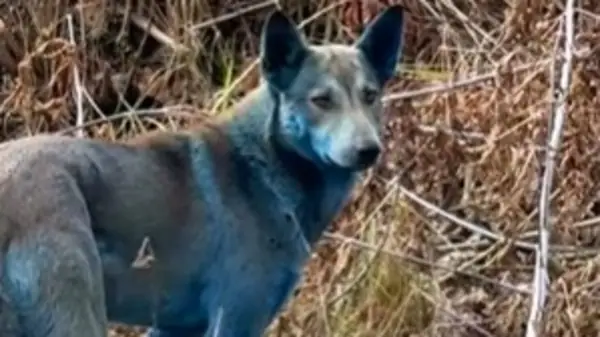
Blue Dogs Of Chernobyl Mystery Deepens After NGO Video Goes Viral - Is It AI Or Real?
Also Read | Gold set for best quarter since Chernobyl. Miners are doing even better.
“We are on the ground now catching dogs for sterilization, and we came across three dogs that were completely blue,” the organisation said in an Instagram post that has now been viewed more than 330,000 times.“We are not sure exactly what is going on.”
Locals claim the animals' fur appeared normal only a week earlier, deepening the mystery.
TAKE A LOOK AT BLUE DOGS OF CHERNOBYLAre the blue dogs real - or an AI illusion?The viral nature of the footage has prompted speculation over whether the blue-coated animals at Chernobyl are real or artificially generated, as AI-created wildlife videos have become increasingly common online. However, the Dogs of Chernobyl team insists the footage is authentic and that its staff are working to capture the animals for examination.
Also Read | 95-year-old woman escapes history's worst tragedies; but a simple walk takes her“We do not know the reason, and we are attempting to catch them so we can find out what is happening,” the group's spokesperson said.“Most likely, they're getting into some sort of chemical.” Despite their striking appearance, the NGO reported that the dogs appeared to be“very active and healthy.”
Who are the dogs of Chernobyl?The animals are descendants of pets abandoned nearly 40 years ago when thousands of residents were forced to evacuate following the Chernobyl nuclear explosion of 1986, one of the worst nuclear disasters in history. Since 2017, the Dogs of Chernobyl project has provided medical care, food, and sterilisation to approximately 700 dogs living within the 18-square-mile Chernobyl Exclusion Zone (CEZ).
The NGO, working under the Clean Futures Fund, said the sight of the blue dogs was“alarming” but stressed that they appeared in good health. Social media users have since flooded the comments section with theories. One TikTok user claimed,“Those blue-tinged fur is a result of external contamination from chemicals, which can be washed off.” Another commented,“Surprised these dogs are still fertile enough to breed, having been in contact with the contaminated area for so long.”
How did the Chernobyl disaster shape the region's wildlife?When Reactor 4 at the Chernobyl nuclear power plant exploded on 26 April 1986, it released the largest amount of radioactive material ever recorded into the atmosphere. Residents were permanently evacuated from Chernobyl and neighbouring towns, leaving behind not only their homes but also their pets. Over time, the absence of humans allowed wildlife to flourish, even amid lingering radiation.
Also Read | Russian takeover of Chernobyl was 'very dangerous': IAEA chiefToday, the Chernobyl Exclusion Zone still registers radiation levels of around 11.28 millirem - roughly six times higher than the safe exposure limit for humans. Yet, life has adapted. The descendants of these abandoned dogs continue to survive, providing scientists with a unique opportunity to study evolution under extreme environmental stress.
Have the Chernobyl dogs genetically adapted to radiation?A groundbreaking 2024 study revealed that Chernobyl's stray dogs may have developed genetic adaptations that allow them to withstand radiation, heavy metals, and pollution. Scientists collected blood samples from 116 semi-feral dogs living near the power plant and in Chernobyl City, discovering two genetically distinct populations compared to other dogs in surrounding areas.
“Somehow, two small populations of dogs managed to survive in that highly toxic environment,” said Norman J. Kleiman, an environmental health scientist at Columbia University, who led the study.“In addition to classifying the population dynamics within these dogs... we took the first steps towards understanding how chronic exposure to multiple environmental hazards may have impacted these populations.”
Also Read | JioCinema rolls out Premium Subscription Plan, offers HBO shows like House of the Dragon and moreThe research, published in Canine Medicine and Genetics in March 2023, identified nearly 400 'outlier loci' - unusual genetic variations - and 52 genes potentially linked to exposure to environmental contaminants. According to the study, this genetic divergence may explain why these dogs have continued to thrive in such a hazardous environment.
Could chemical exposure explain the mysterious blue fur?While the genetic resilience of Chernobyl's dogs is now well documented, experts caution that the blue pigmentation seen in the viral video is unlikely to result from mutation. Instead, researchers suspect the dogs came into contact with a chemical compound or industrial residue - possibly cobalt, copper sulphate, or another metallic by-product from derelict factories near the exclusion zone.
Also Read | Inside Chernobyl, 200 exhausted staff toil round the clock at Russian gunpointFor now, Dogs of Chernobyl is attempting to capture and test the animals to confirm the cause of their bizarre colouring. Until then, the world remains captivated by the haunting images of the blue dogs of Chernobyl - symbols of survival, mystery, and the strange resilience of nature in one of Earth's most radioactive places.
Legal Disclaimer:
MENAFN provides the
information “as is” without warranty of any kind. We do not accept
any responsibility or liability for the accuracy, content, images,
videos, licenses, completeness, legality, or reliability of the information
contained in this article. If you have any complaints or copyright
issues related to this article, kindly contact the provider above.

















Comments
No comment